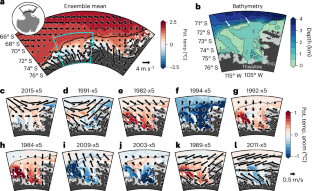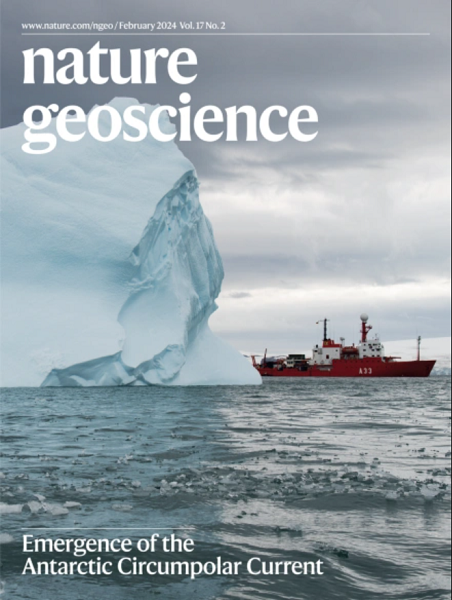Enhanced West Antarctic ice loss triggered by polynya response to meridional winds
IF 16.1
1区 地球科学
Q1 GEOSCIENCES, MULTIDISCIPLINARY
引用次数: 0
Abstract
West Antarctic outlet glaciers are in a stage of rapid ice loss, modulated by wind-driven exposure to warm ocean water. Rapid ice loss probably began in the mid-twentieth century and is often attributed to warmer ocean conditions near the ice shelves driven by strengthening westerly winds at the continental shelf break. This westerly wind trend is a feature of some historical climate simulations but is not supported by proxy (for example, ice-core, tree-ring) observations. Here we present an ensemble of regional ocean simulations and proxy-constrained climate reconstructions and show that shelf-break westerlies are a poor indicator of ocean conditions near the ice shelves. Instead, cumulative northerly wind anomalies close coastal polynyas (open-water regions), driving anomalous warming and freshening near the ice shelves, increasing ice-shelf melting. The increased meltwater leads to strengthening of the undercurrent that supplies warm water, further increasing melting. Our results highlight the importance of local northerly winds and associated sea ice changes for ice-shelf melting in West Antarctica. Proxy reconstructions show a significant historical northerly wind trend in this region, providing the atmospheric forcing that can explain the initiation of West Antarctic glacier retreat in the mid-twentieth century. Ocean simulations and proxy-constrained climate reconstructions suggest that the rapid retreat of West Antarctic outlet glaciers was initiated by local northerly wind trends over the twentieth century.


经向风引起的冰堆反应导致南极西部冰损失加剧
南极西部的出口冰川正处于快速融冰的阶段,受风驱动暴露在温暖的海水中调节。快速的冰损失可能始于20世纪中叶,通常归因于大陆架断裂处加强的西风所驱动的冰架附近海洋环境变暖。这种西风趋势是一些历史气候模拟的一个特征,但没有得到代用观测(例如,冰芯、树木年轮)的支持。在这里,我们提出了一个区域海洋模拟和代理约束气候重建的集合,并表明冰架断裂西风带是冰架附近海洋状况的一个很差的指标。相反,累积的北风异常靠近沿海冰裂湖(开放水域),导致冰架附近异常变暖和变冷,增加冰架融化。融水的增加导致提供暖水的潜流加强,进一步加速融化。我们的研究结果强调了当地的北风和相关的海冰变化对西南极洲冰架融化的重要性。替代重建结果显示,该地区历史上存在显著的北风趋势,提供了可以解释20世纪中叶南极西部冰川开始退缩的大气强迫。
本文章由计算机程序翻译,如有差异,请以英文原文为准。
求助全文
约1分钟内获得全文
求助全文
来源期刊

Nature Geoscience
地学-地球科学综合
CiteScore
26.70
自引率
1.60%
发文量
187
审稿时长
3.3 months
期刊介绍:
Nature Geoscience is a monthly interdisciplinary journal that gathers top-tier research spanning Earth Sciences and related fields.
The journal covers all geoscience disciplines, including fieldwork, modeling, and theoretical studies.
Topics include atmospheric science, biogeochemistry, climate science, geobiology, geochemistry, geoinformatics, remote sensing, geology, geomagnetism, paleomagnetism, geomorphology, geophysics, glaciology, hydrology, limnology, mineralogy, oceanography, paleontology, paleoclimatology, paleoceanography, petrology, planetary science, seismology, space physics, tectonics, and volcanology.
Nature Geoscience upholds its commitment to publishing significant, high-quality Earth Sciences research through fair, rapid, and rigorous peer review, overseen by a team of full-time professional editors.
 求助内容:
求助内容: 应助结果提醒方式:
应助结果提醒方式:


